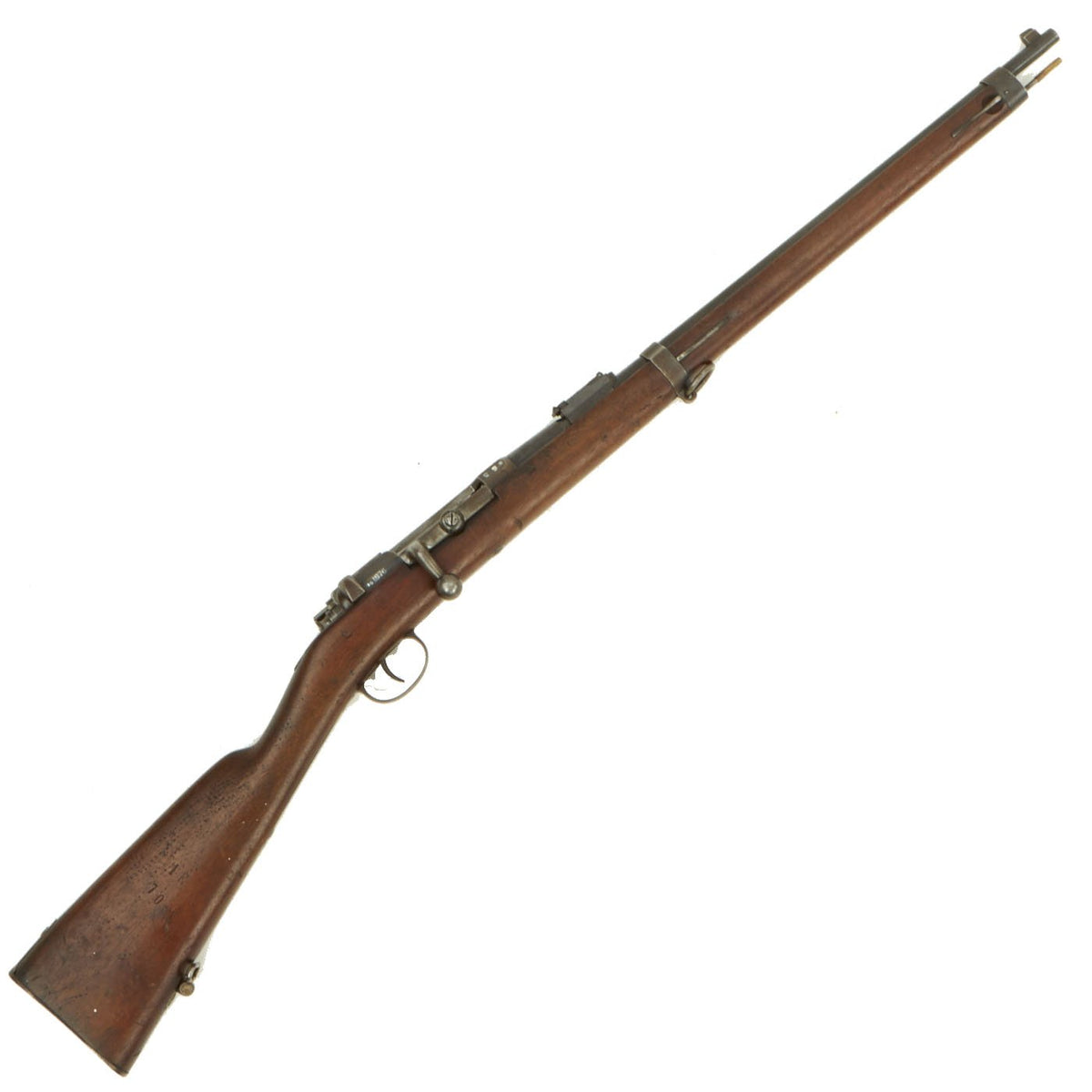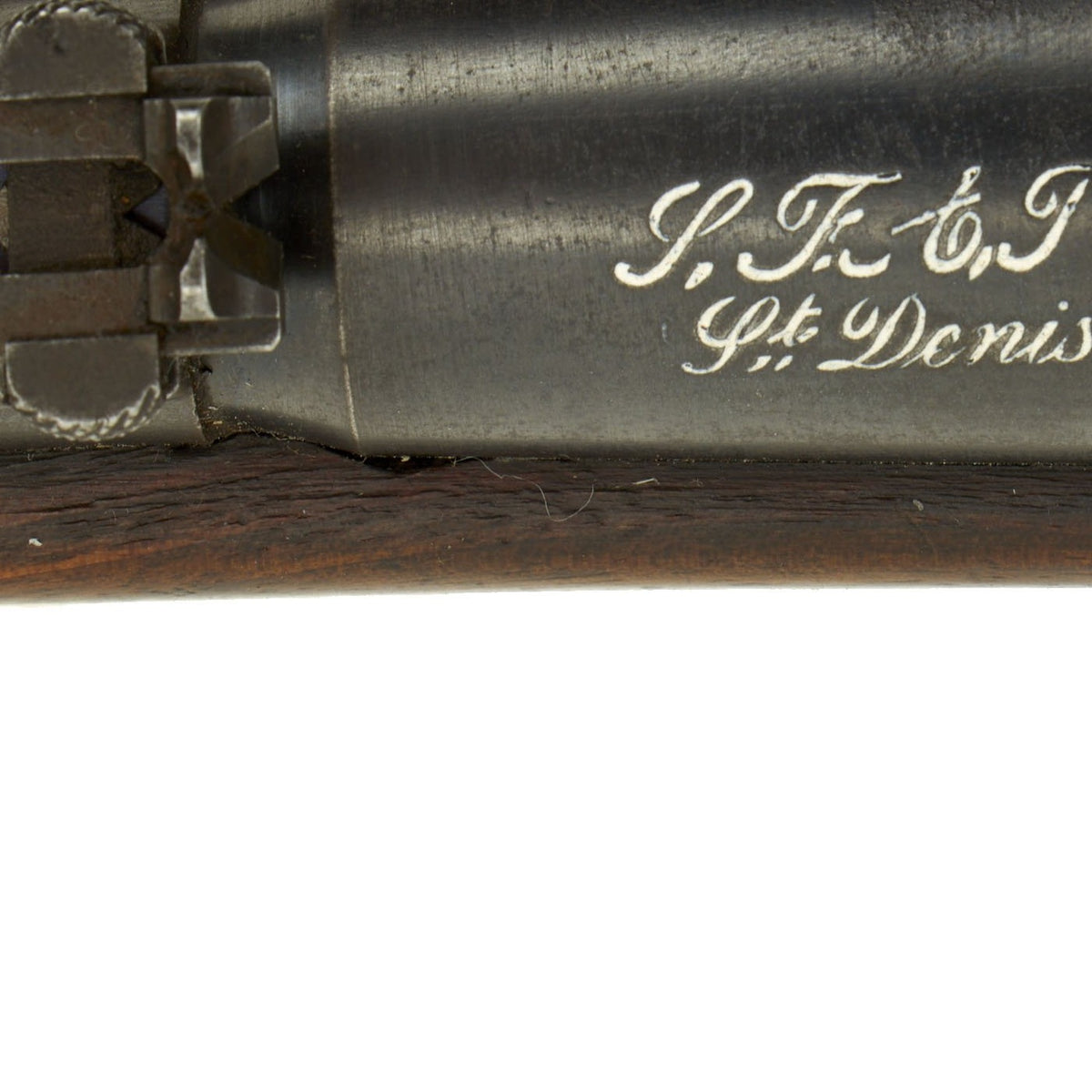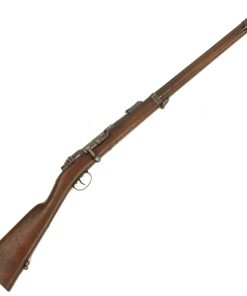Original German Mauser Mod. 71 Converted in France to Uruguay Daudeteau / Dovitis Carbine – serial 8020D Original Items
$ 1.495,00 $ 373,75
Original Item: Only One Available. This is a very nice example of the rare “Dovitis” carbine, which is a French conversion of the German Mauser Model 1871 Infantry Rifle. We have had several of the rifle length examples before, but this is the first carbine we have had! This example bears Serial #8020D on the receiver and bolt, and is marked marked I. G. Mod. 71 on the opposite side in German “Black Letter” type. This stands for Infanterie Gewehr (Infantry Rifle) Model 71. The opposite side of the receiver has the original manufacture date of 1876, with other markings.
The carbine is now chambered in 6.5mm Daudeteau, with a new 22″ barrel, which has a virtually NEW bore. It is bright and shiny, with crisp rifling, and shows no signs of ever having been used. This is a converted carbine that was adapted to the smallbore, 6.5mm Daudeteau cartridge (6.5 x 53.5mm) for Uruguay at the behest of a Uruguayan-Greek named Dovitis.
The work was performed at the St. Denis Arsenal in France and the Lebel type barrel has St. Denis markings on the breech: L. F. t. P / St. Denis. There are also various other proofs and markings on the rifle. The bolt is correct, and has a faded bright steel patina. Bolt action is nice, with a crisp dry fire. Both the extractor and firing pin are present and in good condition.
The walnut stock has a nice oil finish with numerous small handling marks and small blemishes, especially on the right side of the butt stock, which has a has a lot of small dents in lines, probably added on purpose. The original trigger guard was not used in the carbine conversions, so it now has a steel one with no provision for a swivel. A new swivel has been added to the butt stock, and the single barrel band has a large ring on the bottom, correct for the pattern. We assume this is for a sling, and not a saddle ring. Our example is very good and ready to display!
These rifles represented an effort by the Uruguayan government to follow its neighbors and adopt a small bore, smokeless rifle by converting their existing stocks of Mauser black powder rifles at lesser expense. The conversions were well made, but failed for several reasons, not the least of which was the ammunition, which gave very unsatisfactory performance (modern reloaders report good accuracy and excellent reliability with ammunition made from modern components).
In the end, Uruguay was forced to purchase Mauser bolt action magazine rifles to keep up with their military rivals just like everybody else in South America. This is a fine example of a rarely seen Daudeteau conversion and would make a wonderful addition to any collection.
Specifications:-
Year of Manufacture: 1876 – converted later
Caliber: 6.5×53.5mmR French Daudeteau
Cartridge Type: Centerfire Cartridge
Barrel Length: 22 inches
Overall Length: 41 1/4 Inches
Action type: Bolt-Action
Feed System: Single Shot
History of the Mauser 1871
Adopted as the Gewehr 71 or Infanterie-Gewehr 71, or “Infantry Rifle 71 (“I.G.Mod.71” was stamped on the rifles themselves) was the first rifle model in a distinguished line designed and manufactured by Paul Mauser and Wilhelm Mauser of the Mauser company and later mass-produced at Spandau arsenal.
Paul Mauser developed his bolt-action rifle from 1866 to 1871. During 1870-71 trials with many different rifles took place, with the “M1869 Bavarian Werder” being the Mausers’ chief competitor. The Mauser was provisionally adopted on 2 December 1871, pending the development of an appropriate safety. With support from the government’s Spandau arsenal, the improvements to the safety mechanism were completed and the rifle was formally accepted on 14 February 1872 as Infantry Rifle Model 1871 by the German Empire excluding Bavaria. The action was not based on its predecessor, the Dreyse needle gun which had seen service during the Franco-Prussian War of 1870-71, and which was found to have a number of weaknesses.
The now well known Mauser “wing” type safety lever was developed for the Gewehr 71. The Gewehr 71 is a conventional looking bolt action chambered in 11mm using black powder cartridges. The action included only a bolt guide rib as its single locking lug, locking forward of the receiving bridge. The original design was a single-shot. The design was updated in 1884 with an 8-round tubular magazine designed by Alfred von Kropatschek, making this Germany’s first repeating rifle. This version was designated the Gewehr 1871/84. A version of this repeater was adopted by the Ottoman Empire. Designated the M1887, it differentiated from the M71/84 in that it had a side mounted cleaning rod, a second locking lug on the rear of the bolt, and it was in caliber 9.5×60mmR, which Paul Mauser touted as the most efficient (black powder) cartridge. In the early 20th century a few were converted to 7.65×53mm smokeless by the arsenal in Ankara.
NOTE: This gun is NOT considered obsolete calibre, so we are not able to ship to the United Kingdom. Please note that for international shipping, these MUST be shipped using UPS WW Services. International customers should always consult their country’s antique gun laws prior to ordering.
Fast Shipping with Professional Packaging
Thanks to our longstanding association with UPS FedEx DHL, and other major international carriers, we are able to provide a range of shipping options. Our warehouse staff is expertly trained and will wrap your products according to our exact and precise specifications. Prior to shipping, your goods will be thoroughly examined and securely secured. We ship to thousands clients each day across multiple countries. This shows how we're dedicated to be the largest retailer on the internet. Warehouses and distribution centres can be located throughout Europe as well as the USA.
Note: Orders with more than one item will be assigned a processing date depending on the item.
Before shipping before shipping, we'll conduct a thorough inspection of the items you have ordered. Today, the majority of orders will be delivered within 48 hours. The delivery time will be between 3-7 days.
Returns
The stock is dynamic and we cannot completely manage it because multiple stakeholders are involved, including our factory and warehouse. So the actual stock may alter at any time. It's possible that you may not receive your order once the order has been made.
Our policy is valid for a period of 30 days. If you don't receive the product within 30 days, we are not able to issue a refund or an exchange.
You can only return an item if it is unused and in the same state as the day you received it. You must have the item in its original packaging.
Related products
Uncategorized
Uncategorized
Uncategorized
Uncategorized
Uncategorized
Uncategorized
Uncategorized
Uncategorized
Uncategorized
Armored Burgonet Helmet & Polearm from Scottish Castle Leith Hall Circa 1700 Original Items
Uncategorized
Uncategorized
Uncategorized
Uncategorized
Uncategorized
Armoured Fighting Vehicles of the World: AFVs of World War One (Hardcover Book) New Made Items
Uncategorized












































































